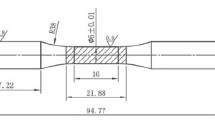Abstract
In this report, we propose a novel inclusion inspection method based on the use of 20 kHz fatigue tests. In these fatigue tests, which take a little time, the most harmful inclusions or internal facets appear automatically at the origin of fish-eye fractures. The novel inclusion inspection employing fatigue tests was demonstrated, in two high-strength steels, to be superior to a conventional inspection by scanning of polished surfaces. Our novel inspection method was first demonstrated with a JIS-SUP12 spring steel that contained relatively large Al2O3 inclusions. The novel inspection method appeared to detect larger Al2O3 inclusions than the conventional inspection, since the inspection volume was 22 times more extensive than that of conventional inspections. On the other hand, there was little difference in the maximum Al2O3 inclusion sizes estimated for several volumes of steel between the novel and conventional inspections. Second an inclusion inspection was conducted on JIS-SCM440 low-alloy steel. For this steel, the discussion focuses on TiN inclusions. Fatigue tests appeared to be the only way of conducting inspections for TiN inclusions, since the inclusions could not be detected in the conventional inspection. In measuring the TiN inclusion sizes, however, etching of the fracture surfaces was found to be absolutely necessary, since the inclusion sizes on the fracture surfaces were significantly different from the true sizes. The difference seriously influenced the estimation of the maximum inclusion sizes. Even in the case of internal-facet-originated type fish-eye fractures etching was found to be necessary, since TiN inclusions occasionally appeared after etching.
Similar content being viewed by others
References
S. Nishijima and K. Kanazawa: Fat. Fract. Eng. Mater. Struct., 1999, vol. 22, pp. 601–07.
K.J. Miller and W.J. O’Donnell: Fat. Fract. Eng. Mater. Struct., 1999, vol. 22, pp. 545–57.
T. Ohshiro, T. Ikeda, H. Matsuyama, S. Okushima, Y. Oki, and N. Ibaraki: Kobelco Technol. Rev., 1987, vol. 2, pp. 36–40.
Y. Murakami, M. Takada, and T. Toriyama: Int. J. Fat., 1998, vol. 16 (9), pp. 661–67.
Y. Murakami, T. Nomoto, and T. Ueda: Fat. Fract. Eng. Mater. Struct., 1999, vol. 22, pp. 581–90.
T. Abe and S. Matsuoka: Trans. JSSR, 2001, vol. 46, pp. 19–25, (in Japanese).
Y. Murakami, T. Toriyama, K. Tsubota, and K. Furuyama: ASTM STP1327, ASTM, Philadelphia, PA, 1998.
T. Abe, Y. Furuya, and S. Matsuoka: Trans. Jpn. Soc. of Mechanical Engineers, 2001, Ser. A, vol. 67 (664), pp. 1988–95 (in Japanese).
ASTM Standard E45, ASTM, Philadelphia, PA, 1997.
E.J. Gumbel: Statistics of Extremes, Columbia University Press, New York, NY, 1957.
Y. Murakami: Metal Fatigues: Effects of Small Defects and Nonmetallic Inclusions, Elsevier, London, 2002.
T. Wu and T. Bathias: ASTM STP1231, ASTM, Philadelphia, PA, 1994.
H. Ishii, K. Yamanaka, and K. Tohgo: Mater. Sci. Res. Int. (JSMS), Special Technical Publication I, 2001, pp. 59–64.
Y. Furuya, S. Matsuoka, T. Abe, and K. Yamaguchi: Scripta Mater., 2002, vol. 46 (2), pp. 157–62.
Y. Furuya and S. Matsuoka: Metall. Mater. Trans. A, 2002, vol. 33, pp. 3421–31.
R.A. Bock and W.M. Justusson: Met. Prog., 1968, vol. 94, pp. 107–12.
S. Yusa, T. Hara, K. Tsuzaki, and T. Takahashi: Proc. Int. Workshop on Innovative Structural Materials for Infrastructure in the 21st Century (NRIM), NRIM, Ibaraki, Japan, 2000, pp. 195–204.
T. Sawai, Y. Kimura, K. Tsuzaki, E. Takeuchi, and S. Matsuoka: Trans. Japan. Society of Mechanical Engineers, 2002, Ser. A, vol. 68 (665), pp. 49–56, (in Japanese).
N.M.A. Eid and P.F. Thomason: Acta Mater., 1979, vol. 27, pp. 1239–49.
L.H. Donnel: in Stress Concentration Factors, ed. Peterson R.E., John Wiley and Sons, 1974, p. 223.
T. Abe, Y. Furuya, and S. Matsuoka: CAMP-ISIJ, 2002, vol. 15, p. 568.
Author information
Authors and Affiliations
Rights and permissions
About this article
Cite this article
Furuya, Y., Matsuoka, S. & Abe, T. A novel inclusion inspection method employing 20 kHz fatigue testing. Metall Mater Trans A 34, 2517–2526 (2003). https://doi.org/10.1007/s11661-003-0011-6
Received:
Issue Date:
DOI: https://doi.org/10.1007/s11661-003-0011-6




